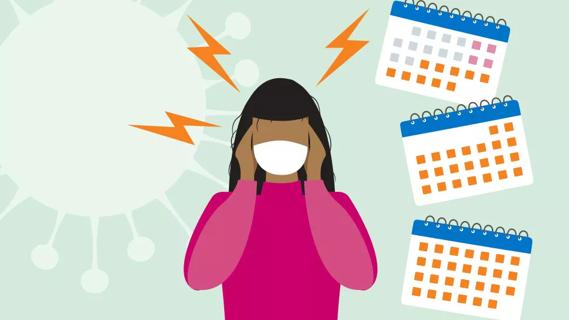Plus, ways to make the changes easier to understand

The CDC estimates that about one in six children aged 3 through 17 years in the U.S. (about 17%) has one or more developmental disabilities.
Cleveland Clinic is a non-profit academic medical center. Advertising on our site helps support our mission. We do not endorse non-Cleveland Clinic products or services. Policy
These disabilities include:
While the pandemic has certainly been tough on most of us, imagine what it’s been like for a child who’s living with a challenging condition and trying to navigate life during the new normal. From their social interactions to their school days, nothing is the same — and they might be struggling to understand why.
This time of uncertainty has created new challenges and frustrations, but it doesn’t have to be completely hopeless for children who have developmental disabilities. Clinical child psychologist, Beth Anne Martin,PhD, offers some helpful insights and advice so you can better understand what your child is going through.
Dr. Martin says that children with disabilities often thrive and cope best when they have a predictable and consistent routine. Unfortunately, the pandemic has made this predictability and consistency harder to achieve.
“Without predictability, children can feel anxious and experience a ‘fight or flight’ reaction. We can see tantrums not only when children are angry but also when they are anxious. It is often their way of protesting a situation that is unfamiliar or confusing. On the other side of the coin, some children react with “flight” and are more withdrawn or shut down.”
To create a sense of normalcy, Dr. Martin recommends establishing a routine for the day even if it’s a new or different routine than your child had pre-pandemic.
“Young children do well with visual schedules that use words and/or pictures to show the order of activities throughout the day and night. Adding in small rewards for doing the activities cooperatively can also add motivation for your child,” says Dr. Martin.
Dr. Martin adds that asking “What do you need right now?” is a great way to understand what is distressing your child and discover the type of comfort they are looking for.
“Validate your child’s feelings about the changes being hard and try to find substitutes for things/activities that are no longer options during the pandemic. Giving choices always helps children and teens feel a greater sense of control during difficult situations,” she adds.
According to Dr. Martin, older children have the ability to pick up more on the emotions and reactions of family members, especially when things are stressful. So they may be experiencing the stress of the pandemic differently from younger kids — and more than their families may realize.
Dr. Martin explains.
“It is important to check in with an older child regarding their feelings, understanding of the virus and how they are managing all of the changes. A teen or tween who is quieter or noticeably more irritable may be holding in some of those emotions or not know how to express their concern.”
As you’re explaining the pandemic and safety protocols to your child, Dr. Martin says that it will definitely take more than words to get your points across.
“When communicating with young children and children with disabilities, we often have to use a variety of methods other than just words, such as pictures, gestures and role play with both toys and people. These can all be important when trying to help young children understand the issues related to COVID-19. Stories are also a strategy youngsters can relate to.”
Dr. Martin suggests keeping in mind that most young children with disabilities need a lot of repetition in order to process and understand concepts and situations. She also says that getting other members of the family involved can be quite helpful.
“Parents and other siblings are a great source of modeling for young children so they should demonstrate their use of masks and social distancing as often as possible. Taking into account the sensory needs of children with disabilities is also important. Some children have aversions to touch that may make wearing a mask harder. In this case, consider modifying the mask in a way that will make it more comfortable and tolerable for your child. You can do so by lining it with a soft or preferred fabric. And if the straps are bothersome to your child’s ears, try a mask that ties behind the head.”
It can be tough in public when others aren’t aware of what your child is going through. People might just assume they’re acting up or very undisciplined. But instead of getting upset, Dr. Martin says educating others about your child’s condition can help promote understanding.
“Sometimes, it is hard for parents when they encounter others who don’t understand their child’s needs or challenges, especially during a difficult time like right now. Educating others about your child’s disability can help at times. When you hear grumblings or see the eye rolls, you can say something like, ‘The pandemic has been hard for all of us, but when you have autism, all of these changes are even harder.’ It can also be helpful to point out the positive coping strategies that your child is trying to employ during a stressful situation. For example, you can say, ‘I know how hard it is to wear your mask at the store, but you’ve done it for 30 minutes and there are only five minutes left. You’re doing a nice job.’ “
If the people who don’t understand are family members, Dr. Martin suggests offering them a favorite book about your child’s disability because it can lead to greater insight and understanding.
Finally, Dr. Martin says to always weigh the activities/circumstances you are considering to determine if they are a good fit for your child at that time. Sometimes, rescheduling an errand at the end of a long day can be more beneficial than trying to power through and risk a difficult outcome for your child.
As Dr. Martin mentioned before, children with disabilities thrive when they have a routine. School days provided a great deal of structure and predictability prior to the arrival of COVID-19. With some kids having to learn at home, it can be a struggle. But there are steps you can take to make it better.
“Even when children are learning online, we can add some of that routine into their day. Make sure your child still has a consistent bedtime and wake-up routine that is similar to when they were going to school. You’ll also want to provide the same kind of movement and cognitive breaks that they received during the school day at home. Also, consider the kind of accommodations and intervention they experienced at school. If they were on an IEP or a 504 Plan, work with the school to make sure those are still in place virtually.”
Dr. Martin says that it’s best to create a quiet learning space for your child and to give them sensory breaks when needed. She adds that some online learning districts have modified their special classes such as physical education or art, but many children with disabilities may still need gross motor and creative/expressive outlets throughout their day. So, get your child outside and engaged in activities that regulate and fulfill their special interest areas.
Socialization has always been a major part of the school day. Since children can start to feel isolated at home, Dr. Martin stresses the importance of finding ways to help them stay connected with their friends.
“Consider virtual lunches with peers during the school day to mimic the lunch table routine at school. Or, see if there are online activities sponsored by the school that your child could participate in with friends. And lastly, find out if it’s possible for them to get individual virtual time with a favorite teacher outside of typical class sessions.”
With teens, things might be a little more complex. That’s why it’s important to help them find meaningful activities that can replace or simulate some of the activities and routines that they were used to — and depended on.
“Sometimes, it just means helping your child shift the way that they engage in an activity, such as still connecting with friends but doing so online or outside with distance and a mask. To understand what your teen is going through, help them identify what they specifically miss about an activity or routine and work with them to find a replacement that can also be meaningful. For example, a teen may say he misses running with the cross country team, but he might really just need the physical input of the activity. So, he could still accomplish this task alone. Alternately, he might truly miss seeing his peers in a social setting and could find comfort in communicating with those peers without needing to run. Ultimately, communication with your teen is critical to problem-solving during this time of change and uncertainty.”
Dr. Martin says that depression and anxiety have a higher incidence in teens with developmental disabilities. If you factor in the pandemic, these teens may be having an even harder time with coping and managing stress.
“Many of the signs of anxiety and depression that we see in typical teens can also be seen in teens with developmental disabilities. Therefore, it’s important to think about your teen’s baseline behavior and mood. Watch for any major departures from their typical ways of interacting and coping. Disruptions in sleep and appetite can also indicate that they are struggling. If their interest and engagement in preferred activities wanes or they isolate themselves more than they did before, these can be warning signs of depression and anxiety. Also, don’t ignore changes in communication or how your child expresses their feelings.” By keeping an eye out, you can act quickly should your child need help.
Learn more about our editorial process.

COVID-19 may be associated with tinnitus, but research is still ongoing

The short answer: It’s complicated, but the basic care precautions still prevail, like washing your hands and isolating if you’re sick

They can feel like a typical headache or a migraine headache, but the pain can last for weeks to months

Any large social gathering — from a family birthday party to an indoor music concert — has the potential to spread serious infection

It’s important to connect with a healthcare provider, get quality sleep and balance your activities with your energy levels

Symptoms can overlap and be hard to distinguish, but there are some telltale differences

Just like the flu, COVID-19 will continue to evolve every year

It’s best to treat flu-like symptoms as if you have COVID-19

Your metabolism may torch 1,300 to 2,000 calories daily with no activity

A gentle touch in all the right places may help drain your sinuses